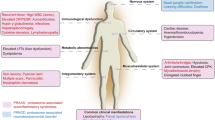Summary
The incidence of allotypes of the genes of the fourth component (C4) and factor B of the complement system was compared in 252 persons under 45 years of fage (“young” group) with 482 people between 61 and 90 years of age (“old” group). One hundred people older than 90 years of age (nonagenarians) were also investigated. A striking difference was found between the “young” and “old” groups in the incidence (16.1% and 5.4%, respectively) of a silent gene of the C4B allele (C4B✸Q0). This difference was even more marked among “young” and “old” men (17.6% vs 3.4%). The incidence of the C4B✸Q0 allele in women dropped to the level of the men only in the nonagenarian group. The most probable explanation for this finding is that people carrying the C4B✸QO allele die from as yet unidentified disease(s) in their middle-age. Therefore, male (and to a lesser extent female) carriers of this allele may have a considerably shorter life expectancy than individuals without a silent gene in the C4B locus.
Similar content being viewed by others
References
Awdeh ZL, Alper CA (1980) Inherited structural polymorphism of human complement. Proc Natl Acad Sci USA 77:3576–3580
Bertrams J, Hintzen U, Schlicht V, Schoeps S, Gries FA, Louton TK, Baur MP (1984) Gene and haplotype frequencies of the fourth component of complement (C4) in type 1 diabetics and normal controls. Immunobiology 166:335–344
Blickle JF, Hauptmann G, Goetz J, Tongio MM, Mayer S, Brogard JM, Dorner M (1988) Polymorphisme du C4 et du facteur B dans le diabete de type 1. Pathol Biol (Paris) 36:791–794
Crawford MH, Grover FL, Kolb WP, McMahan A, O'Rourke RA, McManus LM, Pinckard PN (1988) Complement and neutrophil activation in the pathogenesis of ischaemic myocardial injury. Circulation 78:1449–1458
Hodge SE, Walford RL (1980) HLA distribution in aged normal. In: Terasaki PI (ed) Histocompatibility testing 1980. UCLA Tissue Typing Laboratory, Los Angeles Calif, pp 722–726
Kramer J, Gyódi E, Füst G (1989a) Usefulness of densitometry in typig of human complement component C4. Immunogenetics 29:121–123
Kramer J, Thiry E, Füst G (1989b) Rapid determination of the complement factor B phenotypes. Haematologia (Budap) 22:97–100
Kramer J, Rajczy K, Füst G (1989c) Low incidence of null alleles of the fourth component of complement (C4) in elderly people. Immunol Lett 20:83–85
Lighthart GJ, Corberaud JX, Fournier C, Galenaud P, Hijmans W, Kennes B, Müller-Hermelink HK, Steinmann GG (1984) Admission criteria for immunogerontological studies in man: the SENIEUR protocol. Mech Ageing Dev 28:47–55
Marcelli-Barge A, Poirier JC, Schmid M, Deschamps I, Lestradet H, Prevost U, Hors J (1984) Genetic polymorphism of the fourth component of complement and type 1 (insulin-dependent) diabetes. Diabetologia 27:116–117
Maroko PR, Carpenter CB, Chariello M, Fishbein MC, Radvany P, Knostman JD, Hale SL (1978) Reduction by cobra venom factor of myocardial necrosis after coronary artery occlusion. J Clin Invest 61:661–670
Mauff G (1986) Application of the MHC-class III complement markers to population genetics. Colloque INSERM 142:143–166
Porter RR (1983) Complement polymorphism, the major histocompatibility complex and associated disease: a speculation. Mol Biol Med 1:161–168
Ranford P, Serjeantson SW, Hay J, Dunckley H (1987) A high frequency of inherited deficiency of complement component C4 in Darwin aborigines. Aust NZ J Med 17:420–423
Rich S, O'Neill G, Dalmasso AP, Nerl C, Barbosa J (1985) Complement and HLA. Further definition of high-risk haplotypes in insulin-dependent diabetes. Diabetes 34:504–509
Rus HG, Niculescu F, Porotiu D, Ghiurca V, Vlaicu R (1989) Cells carrying C5b-9 complement complexes in human atherosclerotic wall. Immunol Lett 20:305–310
Sim E, Cross SJ (1986) Phenotyping of human complement component C4. Biochem I 239:763–767
Sim E, Dodds AW (1987) The fourth component of human complement — towards understanding on enigma of variations. In: Whaley K (ed) Complement in health and disease. MTP Press, Lancaster, pp 99–124
Takata H, Suzuki M, Ishii T, Sekiguchi S, Iri H (1987) Influence of major histocompatibility complex region genes on human longevity among Okinawan-Japanese centenarians and nonagenerians. Lancet II:824–826
Welch TR, Beischel L, Berry A, Forristal J, West CD (1985) The effect of null C4 alleles on complement function. Clin Immunol Immunopathol 34:316–325
White PC (1988) Molecular genetics of the steroid 21-hydroxylase and complement C4 genes. ISI Atlas Sci 1:297–302
Author information
Authors and Affiliations
Rights and permissions
About this article
Cite this article
Kramer, J., Fülöp, T., Rajczy, K. et al. A marked drop in the incidence of the null allele of the B gene of the fourth component of complement (C4B*Q0) in elderly subjects: C4B*Q0 as a probable negative selection factor for survival. Hum Genet 86, 595–598 (1991). https://doi.org/10.1007/BF00201547
Received:
Issue Date:
DOI: https://doi.org/10.1007/BF00201547




